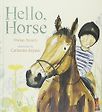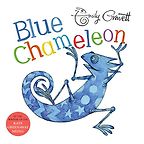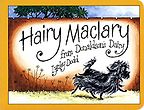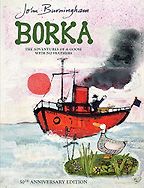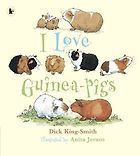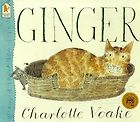What drew you to becoming an illustrator?
I’ve always found drawing therapeutic. I was the child who secretly loved when it rained, as it meant you could stay indoors and draw. I remember loving books, poring over pages, spending far too long looking at one illustration and being excited by what was inside two covers—so to simply open a book was exciting for me.
“You can fall in love with an animal in a book almost as easily as you can one of your own pets.”
My mum was good at finding books—I think her love for them was quite infectious. It wasn’t just picture books. I also loved and love animals. You can fall in love with an animal in a book almost as easily as you can one of your own pets. So another way to have lots of pets was to read about pets! When I wasn’t allowed any more guinea pigs, it was really nice to be able to read about them. I had a lot of little creatures, I had guinea pigs, a fish, a rabbit and a sausage dog. If there was a book about any of them, my mum would pick it up for me.
I’m very struck by the style of your illustrations—they’re distinctive. I’d love you to talk a little bit about your process.
I like to use a variety of things to build up form and texture. My desk is a mish-mash of pots of ink, pens, watercolour, pencils and colouring pencils—even Tippex and other random stuff! I use whatever feels right for each individual character. The backgrounds in my work are often silk-screen printed. I love the contrast between this flat colour, and the marks created with the other materials. I do my screen-printing at Edinburgh Printmakers.
It’s really important to observe the animal properly before putting pencil to paper. Luckily, if you can’t visit an animal in real life we now have access to plenty of footage online. It’s amazing be able to watch how a creature actually moves, how it makes contact with the ground and how it’s form changes when it’s doing different things. It’s good to know your subject as well as you can before creating a picture of them.
But there is an art to creating a good illustrated children’s book, isn’t there? It’s more than a happy accident.
Usually, an animal just pops in to my head and I start to doodle! I can be doodling that creature for months, sometimes years, before a story emerges. My words are inspired by something in the way the animal looks, or an expression he or she might be making. It’s a very organic process.
Get the weekly Five Books newsletter
But I think it is an art and it’s often children’s first experience of art, too. And, it’s art that is shared together as a family, so it’s a bit special. And a lot of people that wouldn’t necessarily go to a gallery, will sit and look at picture books, because it speaks to them a different way. So, it’s a good type of art because you’re accessing people that may not have the opportunity to engage with art in a more formal setting, like a gallery.
Children’s books about pets is a great theme for you to chat about here.
I’m very lucky to have a handful of pet models! My latest book, written by my good friend Vivian French is all about my own horse, Shannon. I know her so well that creating her character for the book came quite naturally. She’s also been rather useful when I’ve been drawing other creatures, Ernest the moose, for example, was loosely based on Shannon. They have similar legs! I also have a fish (Richard), a lovely cat (Ena) and we used to have a dog called Ellie who I drew all the time. They are all very patient models!
My seven year old said to me last weekend, “Mummy, can we get some guinea pigs?” I had to hide my smile. My husband looked at me, laughed and whispered, “You’ve been waiting for him to say that since he was born!”
Hello Horse is your most recent picture book. Is it based on your own pet horse?
I have been drawing Shannon for 21 years exactly! As soon as I got her, I would sit in the field with her and sketch away. I found horses very tricky to draw to start with; I couldn’t get the angles of her legs right. Her hooves didn’t look like they were hitting the ground in a satisfying way. I would never have published any of my early drawings of her—but I do like to keep them all to look back at.
Drawing Shannon used to be was what I called my ‘anti-work’. Drawings I made just for myself so I could spend time with her and enjoy the peace. I know her so well that I could never have written a story about her. One day my lovely friend, Vivian (French) and I were talking about a non-fiction picture book she was writing. We then somehow came up with the idea to write a non-fiction about Shannon. This seemed perfect, as I love Vivian’s writing. I got to draw Shannon in a way that would teach people about horses, and she could be her own character—in real life she is quite a character.
Vivian drafted a text, I did some more drawings, and work on our book Hello Horse began, with a long break in the middle when I had my second baby. Shannon is a very old lady now. I’m so pleased I’ll always have this book about her. The illustrations in the book were made using ink, pencil, watercolour pencils, charcoal and silk-screen printing.
Children and their pets can form very close bonds – so it’s great to have some books recommendations from you about these important animal friends. Your first choice is I Love Guinea Pigs by Dick King-Smith.
As I’m sure you’ve gathered, I just love guinea pigs, and this book was a big inspiration to me. I used to read it and read it. I love Anita Jeram’s drawings of guinea pigs—they’re absolutely exquisite. They look friendly and realistic all at once. They’ve got character. It’s a story about Dick King Smith’s own guinea pigs and there’s a little bit of their history, a bit of non-fiction, a bit of how to look after them, and just some lovely little facts about them—about how they talk to each other and what they’re like with their babies. It’s a lovely starter book for people who are thinking about getting a guinea pig, but it’s also just a nice story. The illustrations are so, so sweet. It’s a truly lovable book.
Next, you’ve chosen Ginger by Charlotte Voake. Tell me a bit more about this book.
Ginger‘s almost in a similar thread to I Love Guinea Pigs, in that it is about the authors own cats—Ginger is a real cat. The design of this book gets me as well. It’s so beautifully put together and so clean because there’s no background. There’s just gorgeous typography telling an absolutely touching story.
Tell us a little bit about the story.
Again, it’s non-fiction. If you’ve got a cat, you can relate to it—but I’d never had a cat when I first read it and I still loved it. And it’s great to read aloud. A few lines just here and there just capture, quite delicately, everything about these two cats.
Five Books interviews are expensive to produce. If you're enjoying this interview, please support us by donating a small amount.
This story is about how Ginger loves his basket and how he loves his life. But then a kitten appears and he’s pretty cheesed off about it. The kitten follows him about and annoys him, and eats his food, and steals his basket. Ginger leaves home because he’s so cross. In the end, of course, the kitten and Ginger become friends and love each other. It’s just gorgeous.
The illustrations are scratchy and simple. I like the fact that they’re a bit wonky. They capture the essence rather than trying to do exactly what is there, which I think is clever. It’s a beautiful, stylish book.
Your third choice is Blue Chameleon by Emily Gravett. Tell us about it.
It’s a kind of book of opposites, but there’s a narrative as well. On one of the pages the chameleon meets a banana, then turns himself yellow and mirrors the bananas shape. My children always laugh at the contorted chameleon!
When the chameleon meets a pink cockatoo, he also tries to mirror it’s characteristics. Young children recognize the bird, but then when they’re a bit older they think it’s funny that the chameleon’s doing an impression. My favourite is what appears to be a plain white page, but then you see that the chameleon is just a raised outline. You can touch the page and feel him, but you can’t really see him.
It’s a simple and quick book. Brilliant for your handbag, because you can just pull it out if you need an ‘emergency story’. I’ve got two copies, a board book and a hardback. I bought it in board so I could carry it about. Emily Gravett is so distinctive. All her books make me smile. She’s brilliant at creating characters and illustrating their expressions perfectly. Emily is very clever in the way that her words and pictures don’t say too much. She leaves just enough to the imagination. My children and I are hooked on her books.
Your fourth choice is Hairy Maclary from Donaldson’s Dairy by Linley Dodd.
Well, Hairy Maclary, a scruffy little dog, trots about town. On the way he gathers up lots of dog friends. They’ve all got funny names; Bottomley Potts (all covered in spots) or Blitzer Maloney (all skinny and boney). It’s told as a rhyming text and it’s lovely to read aloud, and the repetition builds with each new dog. Eventually there are lots of dogs trotting along and then they meet a cat. The dogs are terrified and all run away. And that’s the end of the book! There’s no deep or heavy moral. It’s just funny, really entertaining and fun. Perfect for children who love dogs.
For your fifth and last book you’ve chosen Borka by John Burningham. This is a story about a young goose with no feathers who is left behind when the other geese fly away for winter. Eventually, Borka finds a new home in Kew Gardens, London, right?
John Burningham is so clever and was ahead of his time. His layering and his textures are absolutely phenomenal. The way that his illustrations are put together is fascinating. His mixture of collage and paint washes are a feast for the eye. They are simply beautiful. His compositions and line work are so impressive. He doesn’t draw things to be appealing or cute. He just, I think, draws things how he sees them. Borka is no exception. It’s a stunning book, full of character, texture and charm. It’s a classic that would be a treat for any child to read.
Sign up here for our newsletter featuring the best children’s
and young adult books, as recommended by authors, teachers, librarians and,
of course, kids.
Five Books aims to keep its book recommendations and interviews up to date. If you are the interviewee and would like to update your choice of books (or even just what you say about them) please email us at [email protected]

